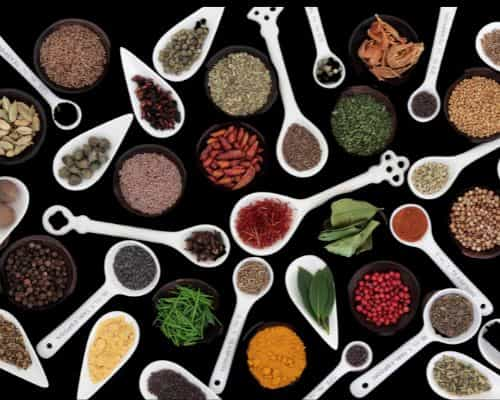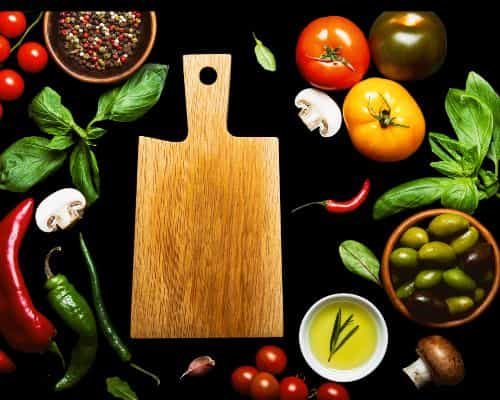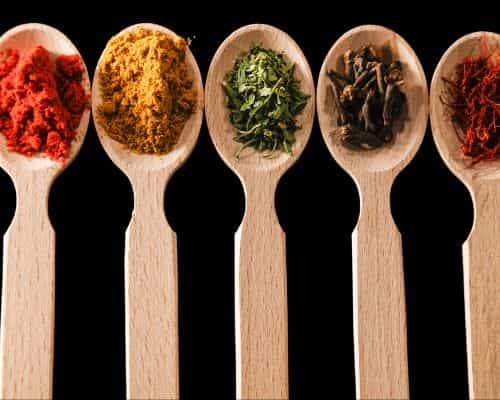If you prepare a food "Au gratin" - what does it mean?

"Au gratin" (pronounced oh GRAH-tan) is a French culinary term that refers to a dish topped with breadcrumbs, cheese, butter, or a creamy sauce, then baked or broiled until golden and crispy. The technique creates a delicious, browned crust on top while keeping the inside creamy or tender. The word "gratin" comes from the French gratter, meaning "to scrape" or "to grate," referring to the crispy topping that’s scraped off the dish. The gratin dauphinois (a famous French potato dish) originally contained no cheese—just cream, garlic, and potatoes!
If you are "Jacquarding"-what are you doing?

Jacquarding (pronounced JAK-ard-ing) is a technique used primarily for tenderizing tough cuts of meat (like steak or roasts) by making small, precise incisions with a jaccard meat tenderizer—a tool with multiple small blades or needles that pierce the meat.
What is a "Mignonette"?

A mignonette (pronounced min-yuh-NET) is a classic French condiment traditionally served with raw oysters or other seafood. It’s a simple, tangy sauce made from: Finely minced shallots - Cracked black pepper - Vinegar (often champagne vinegar or sherry vinegar). The name comes from the French mignon ("small" or "cute"), referring to the tiny shallot pieces.
If you are eating "Pate"- what are you eating?

Pâté (pronounced pah-TAY) is a rich, savory spread made from finely ground meat, poultry, fish, or vegetables, blended with fat, herbs, spices, and sometimes alcohol (like cognac or brandy). It has a smooth or chunky texture and is served cold or at room temperature. Popular types : Pâté en Terrine: Baked in a dish (terrine) and sliced, Pâté en Croûte: Encased in pastry and baked (like a meat pie), Mousse Pâté: Ultra-smooth, whipped with cream or butter (e.g., pâté de foie gras), Rustic Pâté: Coarser textures, like pâté campagne (country-style with pork).
What happens when you "Flambe" something?

Flambé (pronounced flahm-BAY) is a dramatic cooking technique where alcohol is poured over hot food and ignited, creating a burst of flames. The fire burns off the alcohol’s harshness while concentrating flavors and adding a subtle caramelized taste. Classic Flambé Dishes: Bananas Foster (bananas + rum + cinnamon), Steak Diane (beef + brandy + mustard), Cherries Jubilee (cherries + kirsch), Crêpes Suzette (orange liqueur + butter sauce).
Advertisement
If you had a "Rondeau"-what do you have?

A rondeau (pronounced ron-DOH) is a classic, heavy-bottomed cooking pot used in professional kitchens and French cuisine. Think of it as a hybrid between a sauté pan and a Dutch oven! Used for: Braising meats (e.g., short ribs, coq au vin), Simmering stews, soups, or sauces, Searing, frying, or shallow-poaching, Cooking large batches of grains or pasta
What is a "Coulis"?

Coulis (pronounced koo-LEE) is a smooth, strained sauce made from puréed fruits or vegetables, often used to add vibrant color and intense flavor to dishes. It can be sweet or savory, depending on the ingredients. Base Ingredients: Sweet: Berries (raspberry, mango), citrus, or stone fruits. Savory: Tomatoes, roasted peppers, or herbs. Uses: Drizzled over desserts, meats, or as a plate garnish.
What does it mean when you "Render" a food?

Rendering is a cooking technique that slowly melts down solid fats (like animal fat or butter) to separate the pure liquid fat from any connective tissue, proteins, or impurities. The goal is to extract clean, flavorful fat for cooking or to crisp up the remaining solids (like cracklings or lardons).
If you are eating "Carpaccio"-what are you eating?

Carpaccio (pronounced kar-PAH-chee-oh) is an Italian dish of raw meat or fish, sliced paper-thin and typically served chilled with a drizzle of olive oil, lemon juice, and garnishes like capers, arugula, or Parmesan. Invented in 1950 at Venice’s Harry’s Bar for Countess Amalia Nani Mocenigo (who couldn’t eat cooked meat). Named after Vittore Carpaccio, a Renaissance painter known for his red-and-white color palette—matching the dish’s vibrant look!
If you are holding a "Jeroboam"-what do you have?

A Jeroboam is a large-format wine bottle, typically holding 3 liters (equivalent to 4 standard 750ml bottles). However, the size varies depending on the wine region: Bordeaux/Standard Jeroboam: 3 liters (4 bottles). Champagne/Burgundy Jeroboam: 4.5 liters (6 bottles). Wine in large bottles ages slower due to less oxygen exposure, often developing more complexity. Named after Jeroboam, a mighty king of Israel (1 Kings 11:28), symbolizing grandeur.
Advertisement
What does it mean to "Effiler"?

"Effiler" (pronounced eh-fee-LAY) is a French culinary term that means to thinly slice, shred, or finely cut ingredients—often herbs, vegetables, or meat—into delicate strips. It emphasizes precision and finesse in knife work. In haute cuisine, effiler is a sign of a chef’s knife skills, ensuring even cooking and elegant presentation.
If you prepare a meat "Confit"-how are you cooking it?

"Confit" (pronounced kohn-FEE) is a French cooking method where meat (traditionally duck, goose, or pork) is slow-cooked in its own fat at a low temperature, then preserved in that fat. The result is incredibly tender, flavorful meat with a rich texture. "Confit" can also refer to vegetables (like garlic or tomatoes) slow-cooked in oil.




